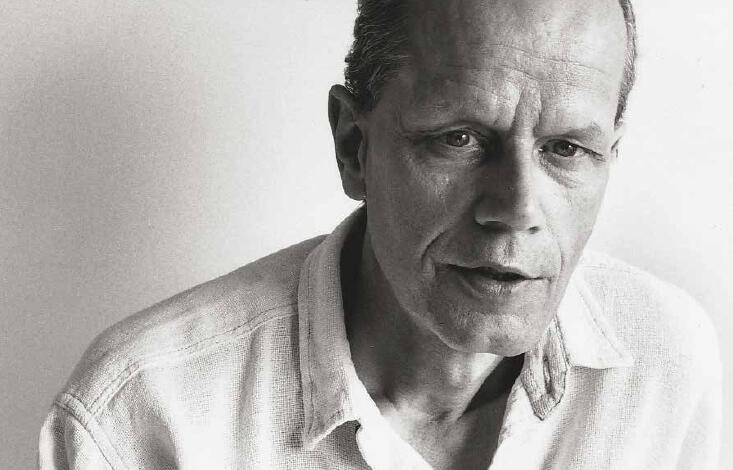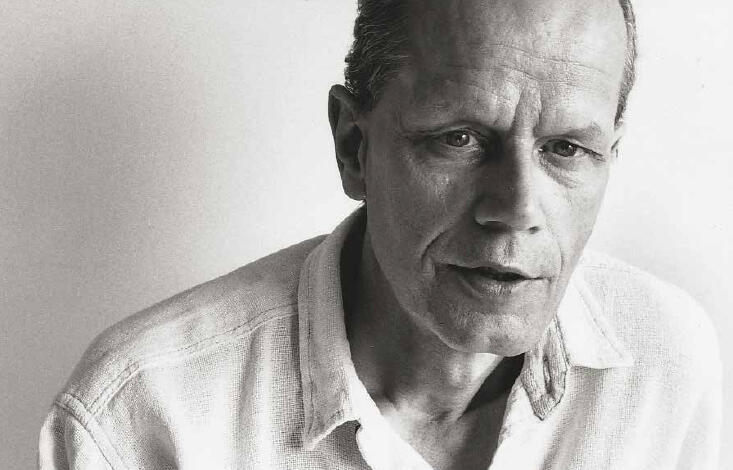GUY BRETT IN CONVERSATION WITH GABRIEL PEREZ-BARREIRO
Gabriel Pérez-Barreiro: Guy, you have worked primarily as an art critic, but you have also curated several very important exhibitions. Many people think these two activities are somewhat incompatible, and there are few cases like yours. How do you approach this crossover, and what makes you decide to curate an exhibition rather than, say, writing an essay about the same artists?

Guy Brett: Strangely enough, my art criticism has always had a strong curatorial element. In the sense that I like if possible to design the pages of the book or article I’m doing, to work with the designer, so that the images relate closely to the text, not necessarily in a simple illustrative relationship, but perhaps more poetic. You would be making ‘exhibitions’ without the hassle of having to assemble the exhibits physically. However, in my view nothing touches the moment when the actual work emerges from the packing case. The physical presence of the work becomes very intense. The object is still transitory; it hasn’t settled in yet to the thought-out, optimum presentation it will be given. I once saw a Rothko exhibition in London at a stage when the great canvases had been taken out of their crates and were leaning against the wall. They seemed somehow more miraculous.
As a curator, do you think the texts you write are of a different genre from art criticism?
G P-B: Yes, primarily because most of the texts I write for catalogues are art historical in nature, and so they tend to be for a more specialized audience. I'm always impressed at real art critics (as opposed to those who just relate what they saw in the most objective terms) who can assemble and communicate an argument based on what they have just seen. To me it seems impossible to think on my feet that fast. I also think that writing for that general non-specialized audience is such a challenge. I enjoy interacting with that audience giving a guided tour for example, but the responsibility of the text terrifies me. One of the aspects of your writing that appeals to me is that you always seem to walk the reader through the experience of the work and almost trace how your opinion was formed. Many of your texts start with a description of a single work, an analysis of your own response to it, a hypothesis on why that might be so, and then a conclusion as to why that is important. It's a very seductive and effective structure. I wonder if you set out to follow this kind of sequence, or if it has just developed over time?
GB: I did a 10-year stint as a newspaper art critic so I know what it’s like to go to your office and write an account of the show you’ve just seen. When I worked for The Times in London articles that had been prepared over days or a week were called “Think Pieces”. But you see, even if you have time to think, knowledge is so partial, so fragmentary. I’ve always been wary of the term “expert”, unless it be used in Rose English’s sense of “being an expert at not being an expert”. I am in awe of precise, detailed, scholarly, art historical writing but “response must come before analysis”, as Maya Deren used to say. Some years ago I became fascinated by the depiction of angels in post-conquest Latin-American painting, especially the disturbing images of angels with guns. There was such an incongruous meeting between the weapon and the sumptuous dress of the celestial figure. I wanted to account for my fascination, but I knew next to nothing about the history of painting in Peru and Bolivia. So I decided to make the article a sort of narrative of a ‘layman’s’ search of the art historical sources to find the answer to a question. I came to the conclusion – I don’t know if it would be accepted or rejected by scholarly opinion – that the angel-figures actually carry two opposed meanings simultaneously: the official and coercive aims of the conquerors, enforced by weapons, and the unofficial and subversive message of the conquered who dream of rebellion with the angel for protection.
I know what you mean by the responsibility of the text, but in reality the scope for misunderstanding is immense. Have you had the experience of someone coming up to you and saying: “I read your piece and I did so agree with you that …. so-and-so and such-and-such …., and you saying to yourself “but that’s not what I meant at all!”
G. P-B. Oh yes! Which just makes me think that all we are dealing with are different degrees of misunderstanding. There’s a certain liberation in thinking that the function of art is to get lost (in the best sense) in possibilities and potentialities. Perhaps it’s a vanity to think that critics or curators can ever really shed light on what art actually does. Some of the best comments I have heard about artworks are by people who have spontaneously arrived at their own conclusions which might be totally ‘wrong’ from a specialist’s point of view, but can also be quite wonderful. Yet at that same time, there is clearly a difference between a well- and a badly-curated exhibition, or a well- or badly-written text, and I think this difference has to do with how the exhibition or the text can encourage you to think or feel differently about a certain artist or work. I do believe that the critic or curator can help to demystify aspects of an artist’s work. I remember in particular your text on Tunga in Transcontinental in which you start with a description of his home in Rio. What might seem like an anecdote is actually a great place to start to understand his broader artistic project which I feel is sometimes lost in a gallery or museum presentation. That’s an example of how a text can introduce elements that an exhibition just can’t. Do you also engage in other types of writing like fiction or poetry?
GB: I did write what I thought was poetry while at school. My best friend was Hugo Williams, who later became a well-known poet, and we used to compare our poems accompanied by an illicit cigarette. I’ve never composed a poem since those days, but I am fascinated by language, by words, and particularly finding words to apply to something that is non-verbal. That’s why I like your Ionesco-like phrase: “different degrees of misunderstanding`’. If we had lived in the late 19th-century we could have compared the role of a Vincent Van Gogh, who adapted certain aspects of Japanese prints to his highly individual mode of perception, with that of his contemporary, the American Henry P. Bowie, who travelled to Japan to learn the principles of Japanese painting first-hand. Despite his dedication, Bowie’s absorption of Japanese aesthetics was in the end a pedestrian understanding, while Van Gogh’s was clearly a creative misunderstanding. We know which we value most.
Curating involves similar paradoxes, I believe one can make a brilliant or a boring exhibition of an artist like Matisse. The question is, does the ensemble of works have what Matisse himself called the “quiverings” of life?
G. P-B: It’s interesting to think about exhibitions in these terms: how they can be greater or less than the sum of their parts. I’ve certainly seen shows where a work was almost destroyed by an unhappy placement, but we like to think that it can survive. However, there are also times (rarely) when the structure of the exhibition is so seductive that you might think a somewhat mediocre artist is more interesting than he/she really is. More often than not, a great exhibition is the one that makes you reconsider someone you just hadn’t been able to understand before. I had that experience in the Cy Twombly galleries at the Menil Collection for example. The space is so perfect in every way that the work speaks in a completely convincing way in its general spirit and every particularity. Those moments are magical and for example it doesn’t happen for me at the more famous Rothko Chapel just a few feet away, where I feel the project gets lost in overwhelming architecture and a kind of new age mumbo-jumbo that just doesn’t seem right for the works. So I guess at the end of the day what we are all trying to do is to present someone else’s ideas and works in such a way that they can speak for themselves. It sounds easier than it really is.
Thank you, Guy, for sharing your thoughts, and I hope we can continue beyond this particular deadline.
.....................................
Gabriel Pérez-Barreiro is an international curator who lives and works in New York. He is the Director of the Patricia Phelps de Cisneros Collection in New York and Caracas. He was Curator of Latin American Art at the Blanton Museum of Art, the University of Texas at Austin from 2002 to 2007; Director of Visual Arts at The Americas Society in New York; Projects Coordinator at Casa de América, Madrid, and founding curator of the University of Essex Collection of Latin American Art in Colchester, England. He holds a PhD in Art History and Theory from the University of Essex, and an MA in Art History and Latin American Studies from the University of Aberdeen. In 2007 he was chief curator of the 6th Mercosur Biennial, Porto Alegre, Brazil.
..................
Guy Brett is a London-based art critic, curator and lecturer on art. He has published widely in the international art press and is the author of monographic essays on Rasheed Araeen, Derek Boshier, Lygia Clark, Eugenio Dittborn, Rose Finn-Kelcey, Tina Keane, Victor Grippo, Brion Gysin, Mona Hatoum, Susan Hiller, Ghisha Koenig, David Medalla, Helio Oiticica, Lygia Pape and Aubrey Williams.
Brett contributed as critic and as curator to the development of European and Latin-American kinetic art during the 1960s. He curated influential exhibitions such as "In Motion", an international exhibition of kinetic art for the Arts Council of Great Britain (1966) and "Force Fields: Phases of the Kinetic" for MACBA in Barcelona and the Hayward Gallery in London,(2001).




